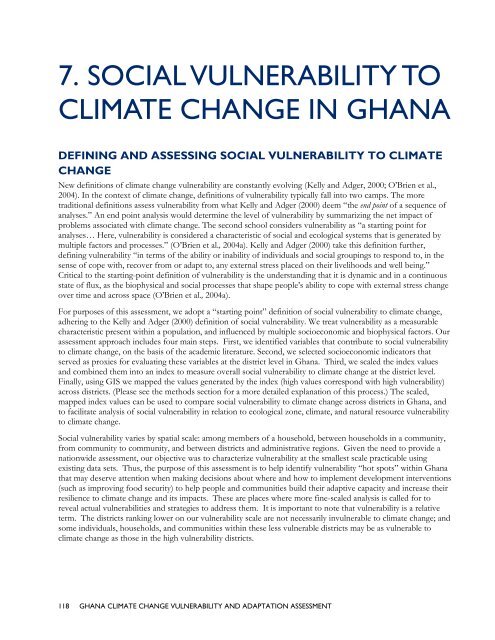ghana climate change vulnerability and adaptation assessment
ghana climate change vulnerability and adaptation assessment
ghana climate change vulnerability and adaptation assessment
- No tags were found...
Create successful ePaper yourself
Turn your PDF publications into a flip-book with our unique Google optimized e-Paper software.
7. SOCIAL VULNERABILITY TOCLIMATE CHANGE IN GHANADEFINING AND ASSESSING SOCIAL VULNERABILITY TO CLIMATECHANGENew definitions of <strong>climate</strong> <strong>change</strong> <strong>vulnerability</strong> are constantly evolving (Kelly <strong>and</strong> Adger, 2000; O’Brien et al.,2004). In the context of <strong>climate</strong> <strong>change</strong>, definitions of <strong>vulnerability</strong> typically fall into two camps. The moretraditional definitions assess <strong>vulnerability</strong> from what Kelly <strong>and</strong> Adger (2000) deem “the end point of a sequence ofanalyses.” An end point analysis would determine the level of <strong>vulnerability</strong> by summarizing the net impact ofproblems associated with <strong>climate</strong> <strong>change</strong>. The second school considers <strong>vulnerability</strong> as “a starting point foranalyses… Here, <strong>vulnerability</strong> is considered a characteristic of social <strong>and</strong> ecological systems that is generated bymultiple factors <strong>and</strong> processes.” (O’Brien et al., 2004a). Kelly <strong>and</strong> Adger (2000) take this definition further,defining <strong>vulnerability</strong> “in terms of the ability or inability of individuals <strong>and</strong> social groupings to respond to, in thesense of cope with, recover from or adapt to, any external stress placed on their livelihoods <strong>and</strong> well being.”Critical to the starting-point definition of <strong>vulnerability</strong> is the underst<strong>and</strong>ing that it is dynamic <strong>and</strong> in a continuousstate of flux, as the biophysical <strong>and</strong> social processes that shape people’s ability to cope with external stress <strong>change</strong>over time <strong>and</strong> across space (O’Brien et al., 2004a).For purposes of this <strong>assessment</strong>, we adopt a “starting point” definition of social <strong>vulnerability</strong> to <strong>climate</strong> <strong>change</strong>,adhering to the Kelly <strong>and</strong> Adger (2000) definition of social <strong>vulnerability</strong>. We treat <strong>vulnerability</strong> as a measurablecharacteristic present within a population, <strong>and</strong> influenced by multiple socioeconomic <strong>and</strong> biophysical factors. Our<strong>assessment</strong> approach includes four main steps. First, we identified variables that contribute to social <strong>vulnerability</strong>to <strong>climate</strong> <strong>change</strong>, on the basis of the academic literature. Second, we selected socioeconomic indicators thatserved as proxies for evaluating these variables at the district level in Ghana. Third, we scaled the index values<strong>and</strong> combined them into an index to measure overall social <strong>vulnerability</strong> to <strong>climate</strong> <strong>change</strong> at the district level.Finally, using GIS we mapped the values generated by the index (high values correspond with high <strong>vulnerability</strong>)across districts. (Please see the methods section for a more detailed explanation of this process.) The scaled,mapped index values can be used to compare social <strong>vulnerability</strong> to <strong>climate</strong> <strong>change</strong> across districts in Ghana, <strong>and</strong>to facilitate analysis of social <strong>vulnerability</strong> in relation to ecological zone, <strong>climate</strong>, <strong>and</strong> natural resource <strong>vulnerability</strong>to <strong>climate</strong> <strong>change</strong>.Social <strong>vulnerability</strong> varies by spatial scale: among members of a household, between households in a community,from community to community, <strong>and</strong> between districts <strong>and</strong> administrative regions. Given the need to provide anationwide <strong>assessment</strong>, our objective was to characterize <strong>vulnerability</strong> at the smallest scale practicable usingexisting data sets. Thus, the purpose of this <strong>assessment</strong> is to help identify <strong>vulnerability</strong> “hot spots” within Ghanathat may deserve attention when making decisions about where <strong>and</strong> how to implement development interventions(such as improving food security) to help people <strong>and</strong> communities build their adaptive capacity <strong>and</strong> increase theirresilience to <strong>climate</strong> <strong>change</strong> <strong>and</strong> its impacts. These are places where more fine-scaled analysis is called for toreveal actual vulnerabilities <strong>and</strong> strategies to address them. It is important to note that <strong>vulnerability</strong> is a relativeterm. The districts ranking lower on our <strong>vulnerability</strong> scale are not necessarily invulnerable to <strong>climate</strong> <strong>change</strong>; <strong>and</strong>some individuals, households, <strong>and</strong> communities within these less vulnerable districts may be as vulnerable to<strong>climate</strong> <strong>change</strong> as those in the high <strong>vulnerability</strong> districts.118 GHANA CLIMATE CHANGE VULNERABILITY AND ADAPTATION ASSESSMENT
















